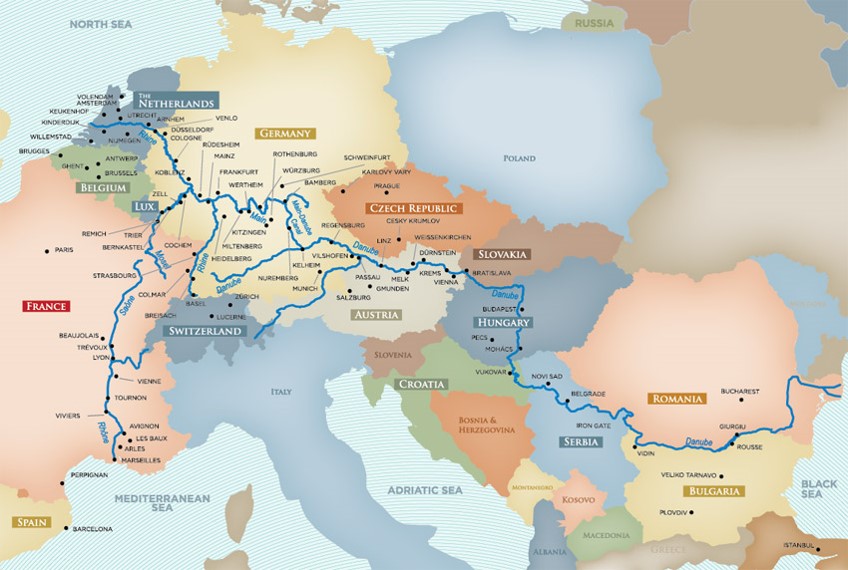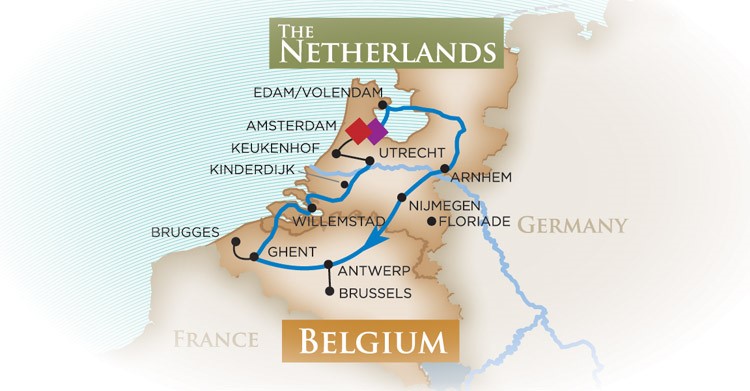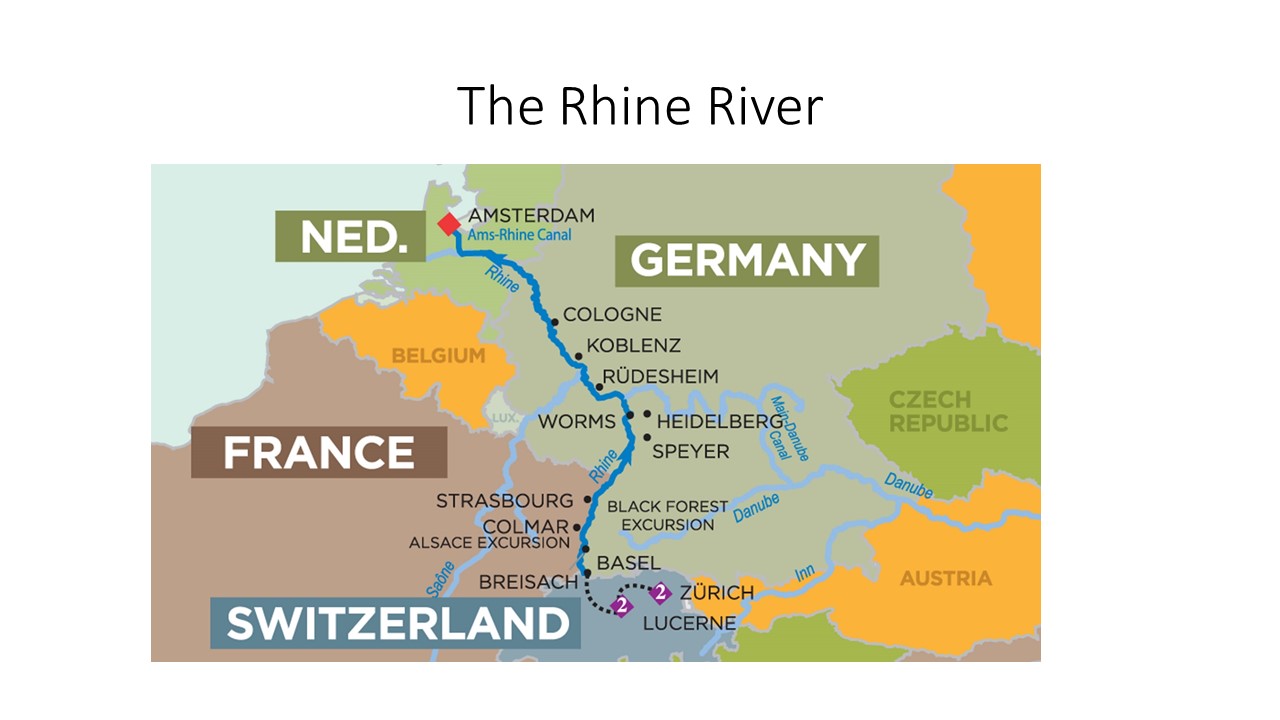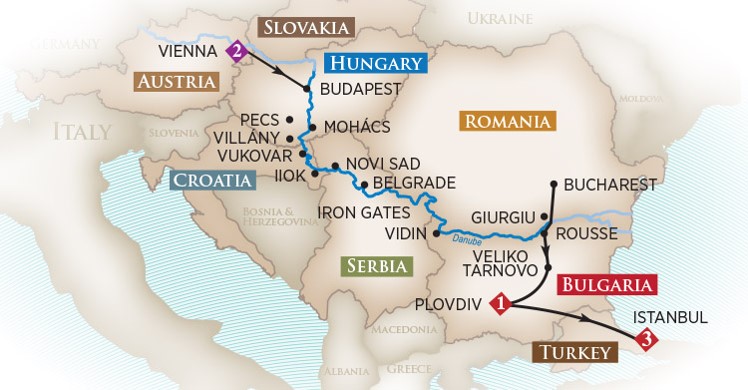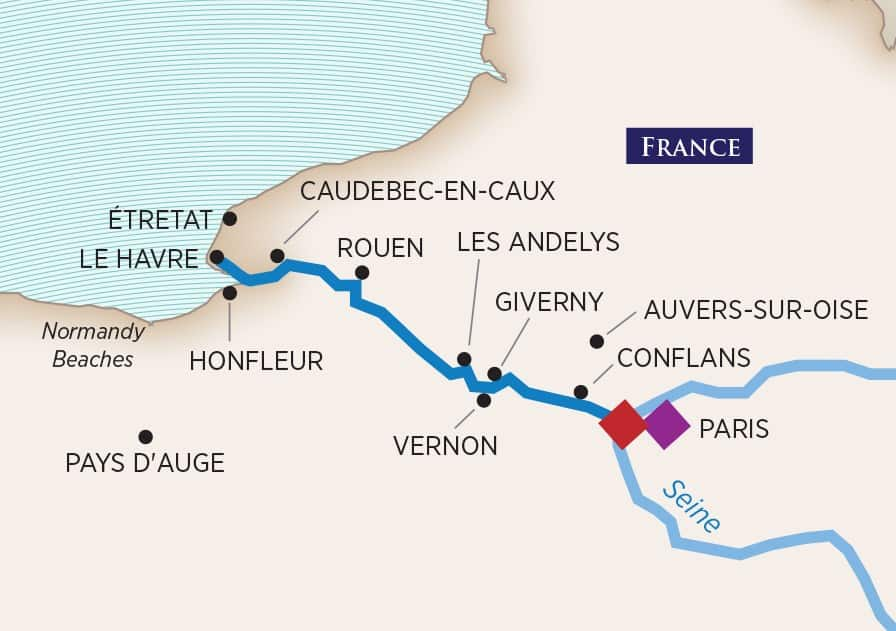Savor Life . . . make memories . . . Visit Dream Destinations! Your journey begins here!
Our Services | River Cruise | Europe Trips | Ocean Cruises | Blog | Specials | About | Travel Request
A Comprehensive Guide to the Best European River Cruise Routes
How to Get the Best European River Cruises
The purpose of this page is provide you a comprehensive guide of the available Europe River Cruise Routes, so you can decide on which route will be the best for your next Europe river cruise vacation.
Europe has the distinction of the continent with the largest number of navigable rivers compared to other regions of the world. They are often devoid of major obstacles such as waterfalls and rapids, and are usually wide and deep enough to allow a steady passage of people and material on all types of sailing vessels. Combine the easy navigation with captivating sights such as castles, vineyards, capital cities and small, quaint villages and it is clear to me why folks would want to sail these amazing rivers!
Europe Rivers Photo Map from AmaWaterways
We are often ask “Which river should we sail on for my first Europe river cruise?” My short answer is take multiple trips--I would sail on all of them! However, the problem is that most of us don’t have unlimited time and money to sail them all.
So to solve this dilemma, here is our guide to the European River routes most available to you. I will describe the river, point out a couple of highlights and why you might consider sailing on this river. The routes may be very short or may cover larger distances. While there are some variations, many lines essentially cruise the same route on the most popular European rivers.
Since most folks want to know what the best starting rivers are if they have never taken a European River cruise, by far the two most popular rivers are the Rhine and the Upper Danube, so let’s explore them first together. Then will examine the remaining Europe Rivers you might want to consider for your vacation.
Ready?—Let’s cruise together!
The Rhine River & Its Tributaries
Much of western European civilization developed around the Rhine River and its tributaries. The Rhine is the busiest commercial river in Europe, yet it is also famous for castles, and vineyards. The commercial boats, along with the local ferries and other boats all seem to work well with river cruise ships and do not detract from the iconic sites along the river, as the best stretches are often protected from commercial activity that could spoil the sights.
The 820 mile Rhine actually passes through 6 countries, but most folks consider it a German River since so much of its banks are on German soil. The middle Rhine and especially the Rhine River Gorge, has the greatest concentration of scenic banks and castles in all Europe. It never gets old!
There are three main routes:
Lower Rhine Northern Loop Route of Tulip Time Map from AmaWaterways
The first route is the Tulip Time route on the lower Rhine and canals in the Netherlands and Belgium in the spring. It is a round trip loop that starts and ends in Amsterdam. Do you love flowers? Then visit the Netherlands in the springtime, when spectacular carpets of colorful tulips are in full bloom on a Tulip Time River Cruise. Throw in lush green countryside adorned with picturesque windmills and add delicious cheeses and already the trip sounds awesome. Also this route can include the Belgium towns of Ghent, Arnhem, Antwerp and our personal favorite Brugge. While once only sailed in the spring, the recent low water problems in Europe has some cruise lines sailing this route during the summer and autumn.
A Typical Rhine River Route. This is the second most popular route on Europe Rivers. Map image is from AmaWaterways
The second route is usually from Amsterdam to Basel Switzerland on the Rhine, (or from Basel to Amsterdam on the next 7 day cruise), using both the lower Rhine and the upper Rhine (the upper Rhine is defined from Koblenz to its source in Lake Constance). This is the second most popular cruise route in Europe. This cruise begins with legendary canals and the colorful surroundings of Amsterdam, past the majestic Cologne Cathedral and on to the Black Forest region of Germany and the Alsace region of France. The best stretch is the Rhine River Gorge with its’ 40 castles dotting the hillsides—unmatched anywhere in the world!
Middle Rhine and Main starting on the Mosel River and ending on the Main-Danube Canal. Route Map from AmaWaterways
The third route is usually from Trier, Germany to Nuremberg, Germany or the reverse route on portions of the Rhine and the Main tributary and part of the Main Canal. It includes the best portions of the Rhine River dotted with picturesque castles from the Rhine River Gorge. The Mosel also has some stunning castles nestled near vineyards and the steep river bank slopes. This route includes visits to two great wine regions of Germany—the Mosel region famous for Riesling wines and the Franconia wine region is less well known producer of dry white wines made from Silvaner grapes. Some consider the Mosel the most beautiful river in Europe—this river has been one of my personal favorites since 1989 on my first visit.
The Danube
The Danube is 1,170 miles, making it the second longest river in Europe after the Volga River in Russia. This is a river of legends, serves a borderline between countries, has four capital cities on or near its banks and romantic sights of medieval castles, baroque churches and abbeys and rococo palaces.
Upper Danube Route Map from AmaWaterways
The Upper Danube is the other great route on Europe rivers (it is the single most popular river cruise route in all Europe—it has about 30% of all river cruise passengers that take a Europe river cruise every year)—and typically goes from Nuremberg or Passau to Budapest. You will get to visit 4 countries, 2 or 3 capital cities (Vienna, perhaps Bratislava and Budapest), castles, Abbeys, wine-sloped terraces and even quaint villages--it is a great voyage. This route sometimes uses the Main-Danube Canal if it goes all the way Nuremberg (106 miles long with 16 locks)—a marvel of engineering and completion of a dream started by Charlemagne in 793 that was finally completed in 1992—about 1200 years later.
Schonbuhel Castle—the Watchman of the Wachau
The completion of this canal connecting the Main tributary of the Rhine to the Danube was the catalyst that got river cruise companies thinking about moving large numbers of passengers along these rivers in luxury riverships—they could see a potential 14 day cruise from Amsterdam to Budapest which is now a standard offering by many river cruise companies.
The Lower Danube
The Lower Danube Route. Map from AmaWaterways
The lower Danube is the gateway to Eastern Europe. This segment begins in Budapest and ends near the Black Sea. It starts with the rolling hills and vine-clad slopes of the Pecs in Hungary; then moves to the boundary waters that separate Serbia and Croatia; then traverses the narrow gorges of the Iron Gates, a stunning passage that divides the Balkan and Carpathian Mountains and either ends in Bucharest, Romania or at the Black Sea.
The Rivers of France
There are 3 rivers in France that are used by the river cruise companies. They are the Seine, the Rhone and the Garonne.
The Seine
Seine River Cruise Route. Map image from AmaWaterways
The Seine route is a 7 day round trip cruise into Normandy, starting and ending in Paris. The cruise highlights are Monet's village of Giverny; the harbor town of Honfleur; Rouen, the historic capital of Normandy and the spot where Joan of Arc was burned at the stake in 1431 (also of special note is the 700 restored half-timber buildings in the old quarter); as well as a chance to visit the medieval towns along this scenic route and visit the D-Day Normandy beaches. This is a gentle voyage along farmland and meadows, historic towns and good food such as brie and camembert cheeses, calvados (apple brandy) and Normandy cider. If you like history, such as the 100 Years War between England and France, want to learn more about the largest amphibious landing in history at the D Day beaches, and like impressionist paintings, this is the cruise for you.
Statue on Omaha Beach
The Rhone
Wine Regions of the Saone and Rhone. Map image from AmaWaterways.
The Rhone and Saone cruise goes from Lyon to Arles. Starting in Lyon, the gastronomical capital of France, the cruise goes through France's legendary wine growing regions of Beaujolais and Cote du Rhone, and allows you observe medieval villages in the Provence region of France. Then on to the Papal town of Avignon and finish in Arles, where Vincent Van Gogh spent much of his time. The cruise then changes direction from Arles to Lyon for the next 7 day cruise. You will sample great wines, visit Roman ruins, and learn about the cuisine of Provence, among stunning scenery—fields of purple lavender, yellow sunflowers and vineyards. We have sailed on this route 3 times and each time it was awesome—we are ready to return anytime
Pont du Gard
Bordeaux Region Cruises
A typical Bordeaux cruise route. Map from AmaWaterways
The newest river cruise is in the Bordeaux region of France on the Garonne, Dordogne and Gironde Rivers. It is a round trip cruise out of Bordeaux and features wine tastings, chateaux’s and abundant vineyards along the Garonne and its tributaries. There are over 8,500 wine producing estates in this region—it is often considered the wine capital of the world. Usual port cities of Cadillac, Pauillac, Bourg and Libourne are included in most sailings of this region. This is an important wine region of France and you will experience tastings of some of the most distinguished wines including Sauternes, Medoc and Bordeaux wines. If you like wine, cognac, oysters, truffles, chateaux and the grand buildings of Bordeaux, this is the cruise for you.
Wine Regions of Bordeaux. Map from AmaWaterways
Bordeaux Habour
The Douro
Typical Douro cruise route. Map from AmaWaterways
The Douro (Douro translates as Gold in English) is a Portugal round trip adventure, usually starting and ending in Porto, Portugal. This region is famous for Port Wine. The only river cruising in Portugal is along the Douro River. This river starts in the high hills of Picos de Urbion and flows west to the Atlantic Ocean.
Porto is the second largest city in Portugal and famous for Port wine and seafood. The Douro is an unspoiled river decorated with deep gorges, lush vineyards and sleepy fishing villages. Also many manor homes and wine growing estates are waiting for cruisers to explore, along with the small fortified village Castelo Rodrigo. Many cruises offer a chance to visit the Spanish villages of Salamanca and Vega Terron, two important medieval towns. This is a cruise for wine lovers, especially the desert wine port, also a cruise for those who want to sample and learn more about Portuguese cuisine, and for adventures who love new destinations.
Some of the vineyards on the Douro River. The photo was taken by our clients the Howards on their Douro Cruise.
Porto, Portugal. This photo was taken by the Howards on their AmaWaterways Douro Cruise.
The Volga
The 2,294-mile-long Volga is the largest river in Europe. The river is often referred to as “Mother Volga”, because it is so important to the lives of the Russian people. Due to Russian laws, cruise lines can only lease their ships, so sometimes the normal comforts and high standards of Europe cruise lines are not always available on Volga River cruises. One cruise line, Scenic, has built a new vessel that really approaches the expected standards of Europe river cruises. Currently, Scenic, Uniworld and Viking sail the Volga.
The political situation of Russia and US have reduced the demand here and the future is uncertain at best.
On a typical Volga cruise, the route is from St. Petersburg to Moscow (or reverse) and these two cities dominate the cruise itineraries. In Moscow, a visit to the Kremlin, shows the power of the largest country of the world. In St. Petersburg, the most western of Russian cities, the Hermitage museum, Catherine’s Palace and Peterhof are a unique look at the lives and treasures of the tars of Russia. Expect a 2 week or so cruise—it will always be longer than a week cruise..
There is more to see than these two great cites. They include Kizhi Island, an isolated tourist destination set at almost the center of Lake Onega, home to an open-air museum made up of more than 80 wooden buildings. In the small river town of Goritsy travelers can visit the Kirillo-Belozersky monastery, which was built in 1397 and is home to a vast collection of Russian Orthodox icons. Yaroslavl, a city located at the intersection of the Volga and Kotorosl Rivers, is another important site for Russia. It is one of eight principal cities that make up the Golden Ring, a group of ancient cities and towns that were instrumental in the founding of the Russian Orthodox Church.
A Volga cruise offers a chance to see Russia’s two largest cities, learn about rural Russia and the history of the Russian Orthodox Church .It also offers a chance to sample some Vodka and caviar. The Volga is famous for its caviar—4 species of sturgeon live in the river and make many very happy with this gourmet delight. This is a great cruise for the experienced traveler who wants a window into Russia
Samson Fountain at Peterhof Place, just outside of St. Petersburg
The Elbe and the Po
Lesser known routes include the Elbe (Germany) and the Po (Italy).
If you are a real student of Europe River Cruising and my blogs, you may have noticed I did not include glowing reports of two river systems in earlier blogs—the Elbe and the Po. I have a difficult time recommending these cruises—many times folks who chose these routes are disappointed.
The Elbe (724 miles long) is primarily located in the eastern part of Germany and provides a good chance to see eastern Germany and parts of the Czech Republic. It is a very shallow river and cruises often become glorified bus tours, as the low water levels restrict the ability to safely sail these rivers.
Only 2 river cruise companies at present sail the Elbe. They are Viking and CroisiEurope. If you really want to sail the Elbe, you might consider the paddlewheel ships of CroisiEurope, but be prepared for a cruise where the primary on-board language is French. Highlights of this cruise route include Berlin, Hamburg, Wittenberg (where Martin Luther started the Protestant Revolution) the palace of Sanssouci in Potsdam (Fredrick the Great’s Prussian palace) and Prague. For some, the outstanding sites to visit make this a great trip, but as they say, go with the flow if you choose this cruise—most reviewers claim the Elbe is the most cancelled or modified Europe river cruise.
This paddle wheel boat is in Berlin, Germany but very similar to one used by CroisiEurope on the Elbe River.
The Po is a glorified bus tour, in my opinion, as only 100 miles or so of the cruise is sailing on the Po; the rest is bus tours to the sights. Navigation is the problem on the Po; it is a very swift-flowing river and has obstacles such as constantly shifting river banks. This cruise will spend most of its time in or near Venice. Uniworld and CroisiEurope sail this route.
Uniworld is the only US major cruise line to offer this tour. The boat is really more a stationary hotel, with minimal cruising. Cruise and bus tours visit Venice, the Po River Delta areas, the islands around Venice and Verona (Roman amphitheater and Romeo and Juliet fame). It also offers a good chance to sample the local cuisine, including Bologna (cold cuts) and Parma (hams and cheese).
We would recommend these only for really experienced river cruises or those with a very special interest in these limited river cruises
My Final Thoughts
What a lot of great choices—I’m ready to go!
While there are some variations, many lines cruise essentially cruise the same routes on the most popular European rivers. The river routes may be very short or may cover larger distances, depending upon the route you select. While I have covered primarily 7 day cruises, many of these routes can be combined for longer cruises of 14 or 21 days or more. River cruising is about the destinations, in my opinion, so the correct itinerary is critical to provide you the river cruise experience you desire for these special trips. We hope this quick summary will provide you a good overview of what is possible in Europe river cruising.
Every major cruise company also offers pre/post stays so along with the river cruise you can get some extended time in some of the best of Europe's cities. We have been to almost all major cities in Europe and we have developed our own guides for 50 top Europe cities, so not only can we provide information on pre/post stays, we can also plan your stays to customize your trip

